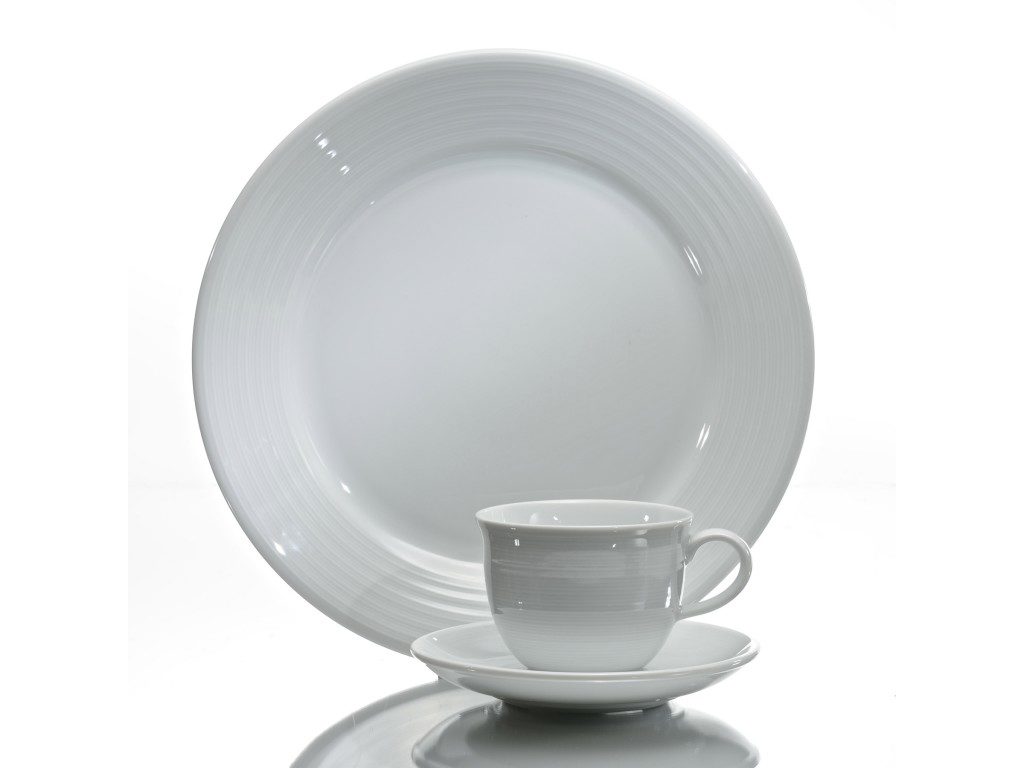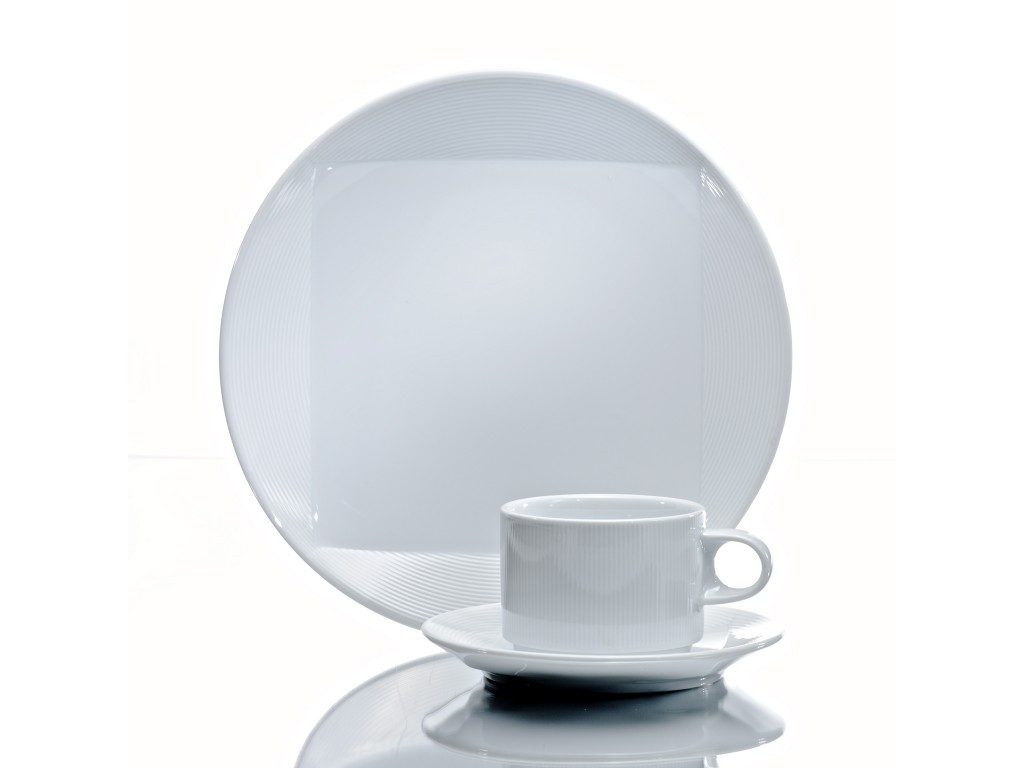Oneida Group, Inc. v. Steelite International U.S.A. Inc. is a demonstration of how our jurisprudence is essentially useless in deciding trademark ownership claims. The dispute is over ownership of the trade dress in the highly successful “Botticelli” and “Nexus” tableware patterns, part of Oneida’s “Sant’ Andrea” line:


The tableware is considered premier and sold to hotel, cruise lines and fine dining establishments. Botticelli is Oneida’s number one product. The tableware is manufactured by non-party Royal Porcelain of Thailand; Royal Porcelain sells the plates exclusively to defendant Tablewerks and Oneida buys the dinnerware from Tablewerks. Oneida sells directly to a few customers but largely does business through dealers. Oneida had been buying from Tablewerks for nineteen years on an exclusive basis, that is, Tablewerks had a policy that one product went to one customer but there was no written agreement memorializing that practice. The owner of Tablewerks testified that the policy was good for both companies.
Defendant Steelite bought Tablewerks and the next day communicated to Oneida that:
Steelite [had] acquired substantially all assets, intellectual property, and other rights of Tablewerks.… Please be advised that … Steelite intends to self-distribute all product produced by Royal Porcelain under the Royal Porcelain back-stamp. While we are advised that there is no contractual relationship between [Oneida] and/or its affiliates [], on the one hand, and Tablewerks and/or Royal Porcelain on the other, in an effort to facilitate a seamless transition, Steelite is prepared to accommodate [Oneida]… .
Steelite also said it would fulfill all existing purchase orders on the current pricing terms; not object to Oneida’s sale of its current Royal Porcelain inventory; respect Oneida’s intellectual property such as the “Sant’ Andrea” name and back-stamp; and asked that Oneida similarly honor Steelite’s intellectual property.
All hell broke loose, with Oneida having to field customer inquiries expressing confusion and losing $1 million in sales in two months’ time. Oneida sued, claiming that it owned the trade dress in the plate designs.
Already we can see that this case doesn’t fit well into standard manufacturer-distributor framework. The manufacturer, Royal Porcelain, is a non-party that, by contract, supplied exclusively to Tablewerks. We can view it as Tablewerks in the role of manufacturer, but the facts still aren’t that simple. Two men, David Queensberry and Martin Hunt, founded the design firm Queensbury Hunt, renowned for designing tableware. The firm designed both products. Queensbury and Hunt assigned the Botticelli design to Tablewerks, receiving royalties in exchange, and Tablewerks filed two design patents for the tableware. Queensberry Hunt also “assigned [Nexus] to Royal Porcelain and Tablewerks” and the “copyright … to Royal Porcelain.” (The distinction isn’t relevant in the decision, but quoted for accuracy.) Tablewerks (not Royal Porcelain or Oneida) paid Queensberry Hunt a running royalty on the designs. When Steelite acquired Tablewerks, it acquired all the intellectual property rights that Tablewerks had. In sum, Royal Porcelain and/or Tablewerks owned the design patent rights and copyright in the tableware design, a point Oneida did not dispute.
The court describes the ownership situation thus: “Oneida, Steelite, and Tablewerks are all distributors. The manufacturer of the dishes, Royal Porcelain, is not a party to the action. Oneida claims that it owns trade dress rights, and that those rights are superior to not only to Tablewerks, but also to the manufacturer, Royal Porcelain. Oneida has never had an agreement with Royal Porcelain. Oneida claims that it has a contract with Steelite [sic, Tablewerks?], which is discussed below, but for purposes of this analysis, Oneida has not claimed that it has a contractual relationship which confers ownership of intellectual property rights.”
The court nevertheless applied the test commonly used for manufacturer-distributor relationships:
As a general rule, where a manufacturer and exclusive distributor contest the ownership of a trademark and no agreement controls, it is the manufacturer who presumptively owns the mark, even where the manufacture is located outside the United States.
However, where, as here, the goods pass through a distributor’s hands in the course of trade and the distributor gives them the benefit of its reputation or of its name and business style this presumption may be rebutted. In order to determine whether a distributor can rebut the presumption, a court should consider the following factors: (1) which party invented and first affixed the mark onto the product; (2) which party’s name appeared with the trademark; (3) which party maintained the quality and uniformity of the product; and (4) with which party the public identified the product and to whom purchasers made complaints. In addition, a court may look at which party possesses the goodwill associated with the product, or which party the public believes stands behind the product.
(Internal brackets, quotation marks and citations omitted.) Apparently the court assumed, without stating so expressly, that for purposes of the presumption Tablewerks was the manufacturer.
As to who invented and affixed the mark onto the product, Oneida claimed to have collaborated with Queensberry Hunt in the design but the facts, as weighed by the court on a motion for preliminary injunction, were that Oneida had not. As to which party’s name appeared with the trademark, the “back-stamp” on the dinnerware is “Royal Porcelain” and “Sant’ Andrea,” but it didn’t include the word “Oneida.” Oneida’s name didn’t appear on the packaging either and the court didn’t think that Oneida’s name in the marketing literature was relevant. [Ed. note: totally disagree with that, I think it’s highly relevant.]
The court thought that all the remaining factors were “inextricably intertwined” and so considered them together. And here we have more complexity—Oneida is only a step in the distribution chain, so who is the “public” that matters, is it the ultimate purchaser or Oneida’s dealers? The only evidence from an end user was from the Director of Food and Beverage at Marriott, who changed his testimony between the TRO and the preliminary injunction. His declaration for the TRO was that Botticelli and Nexus were “synonymous” with Oneida; however he later amended his declaration to say that Botticelli and Nexus were “marketed by” Oneida. There was also testimony that a number of end users, including Royal Caribbean Cruise Line, Marriott, Carnival Cruise Lines, KLM Airlines and Northwest Airlines, made multiple visits to the Royal Porcelain factory in Thailand. Oneida’s own evidence on its customer interactions showed “that Oneida is a distributor. The summary shows that 95% of the calls did not relate to quality—they related to ordering the plates.” Oneida offered a warranty, but a dealer testified that he often fielded complaints about the tableware and offered a warranty too.
Oneida had weak evidence that it controlled the quality of the goods; it tested them but:
it is unclear to the Court what the purpose of Oneida’s testing is, but there was no evidence that, after testing, Oneida communicated with Royal Porcelain or Tablewerks to augment the dishes in any way. So although it is clear Oneida tests the quality of the dishes, Oneida has not made a sufficient showing at this juncture to claim that it in any manner maintains the quality of those dishes.
So while Oneida succeeded in obtaining a temporary restraining order, it failed to obtain a preliminary injunction. Steelite is now selling the patterns under the “Belisa” and “Vortex” brands.
As disruptive to Oneida’s business as this is, I don’t have too much sympathy for Oneida. First off, not having an exclusive contract for the supply of a leading product that you’ve been selling for 15 years seems, um, short-sighted. Which is perhaps why, before Steelite bought Tablewerks, Oneida had already been working on finding a replacement for Royal Porcelain.
Reading the decision, I don’t have any doubt that the outcome is right. There was a lot of evidence that before the lawsuit Oneida didn’t think it was the owner of any rights. It produced an IP Matrix listing Tablewerks as the owner of the Botticelli and Nexus designs with Oneida having distribution rights. Oneida referred a potential infringement to Tablewerks to deal with. Oneida told customers it was creating a “Botticelli-like” design—if it owned the design it wouldn’t have had to inform customers that the design might change.
But I’m less interested in the outcome than how we get to it. This case exposes the inadequacy of the jurisprudence for deciding ownership. The standard manufacturer-distributor test may be adequate for the simple world where one party purchases from an unrelated manufacturer, but the factors were of little service in assessing ownership in this complex situation. Take for example which party’s name appeared with the trademark and with which party the public identified the product. First off, although considered different factors, they are at least related, if not the same—the consumer will presumably cue from what information the parties have given them. The name on the product is, though, useful as evidence of what the parties thought. The labeling doesn’t happen by accident; product labels and packaging are created and approved. But even so, here it’s of little use because we have “Royal Porcelain,” the manufacturer but who nobody claims is the owner, associated with the mark “Sant’ Andrea,” a mark no one disagrees is owned by Oneida, although there is no evidence of consumer association of “Sant’ Andrea” with Oneida. So labeling does nothing to help us out here.
Control over the quality of the goods is generally considered the fundamental signifier of ownership. It might make sense as the most relevant question of all if we made the consumer’s interest in getting consistent quality of product the primary interest. But we don’t always consider it primary (looking at you, Kevin!, (Hein Online paywall)), and I’m not sure that consumer interest should override the parties’ interests. But even if it does, what does “quality control” mean really? A manufacturer of course has a quality control role, but the party with the competing ownership claim may equally control quality by choosing who the manufacturer will be. That type of quality control is the genesis of the quality control (versus source) concept of trademark ownership stated in Menendez v. Holt, 128 U.S. 514, 520, 9 S. Ct. 143, 144 (1888)—the mark “La Favorita” evidenced “that the skill, knowledge and judgment of Holt & Co. had been exercised in ascertaining that the particular flour so marked was possessed of a merit rendered definite by their examination and of a uniformity rendered certain by their selection.” “Quality control” can be exercised on different levels, as it was here, so merely identifying “quality control” as a factor gives us evidence but no idea how to consider it.
Who the public associates with the mark can range from “no one,” to multiple parties (labels commonly have more than one name on them), to, as here, a company that appears not to own any rights. Complaints are likely to be made all the way up the distribution chain; one most likely complains to the person with whom you have the direct relationship. And what about companion intangible rights, should we have a doctrinal preference that all the intellectual property rights be consolidated in one owner? That traditionally hasn’t been true; often copyright and trademark ownership are different, sometimes creating a stalemate, where, for example, a logo designer tries to enforce copyright against the trademark owner.
The current doctrines extract evidence, but at the end of the day we don’t know what relevance any of the evidence has or how to weigh it. I don’t have any answer, still working on it.
Oneida Group, Inc. v. Steelite Int’l U.S.A. Inc., No. 17-cv-0957 (E.D.N.Y. May 10, 2017)(preliminary injunction)
Oneida Group, Inc. v. Steelite Int’l U.S.A. Inc., No. 17-cv-0957 (E.D.N.Y. March 14, 2017)(temporary restraining order)

This work is licensed under a Creative Commons Attribution-NoDerivatives 4.0 International License.

Leave a Reply